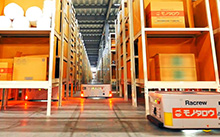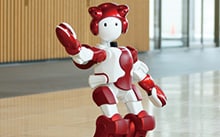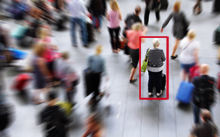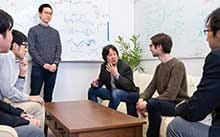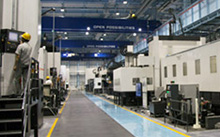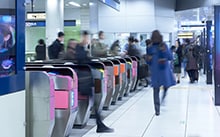As societies grow increasingly complex, IT is playing an increasingly important role in optimizing various social systems. To make everyday life safer and more convenient, Hitachi has focused attention on the flow of people. Hitachi's simulation technologies for people flow analysis have helped facilitate pedestrian flow. The technologies have also helped optimize use of public spaces and added value in the form of more vibrant and more attractive cities.
IT has been contributing to improvements in efficiency and the optimization of various social systems, including ones that create more efficient traffic systems and reduce CO2 emissions. However, IT is not just for social systems. As a pioneer in the utilization of IT to reinvent infrastructure for Social Innovation, Hitachi has been advancing a new approach, focusing on people flow analysis. This is an effort to create added value through the analysis of people's movement, behavior and relationships.
This initiative began in 2007 when Hitachi co-developed three-dimensional pedestrian-flow simulation technology along with the Shin Morishita Laboratory at Graduate School of Yokohama National University, East Japan Marketing & Communications, Inc., and MOSAIC Co. Ltd. This technology makes it possible to measure the movement of people inside a building and simulate the flow of people throughout the structure. This technology was developed to optimize the placement of hallways and elevators in the design of office and large-scale commercial buildings.
Since then, Hitachi has been working to apply this three-dimensional pedestrian-flow simulation technology to railroad facilities and has conducted experiments in Osaka-Uehommachi Station in cooperation with Kintetsu Corporation. Utilizing data from the experiments, the station repositioned its mobile digital signage. This change in space management helped increase the flow of people to shops within the station and reduced congestion in the surrounding areas.
Through these experiments, Hitachi reinforced the idea that understanding and predicting the flow of people can create new value in a variety of ways. A good example of this comes from an experiment done at the Hitachi Innovation Forum 2013, a trade show the Hitachi Group holds each year. Hitachi used laser sensors to measure the movement of people and the amount of time they spent at various locations inside the event venue. The results revealed congestion in certain areas that prevented the smooth flow of people. Analysis of the data also indicated that the "pull power" of booths varied widely based on their location, with some exhibition booths getting ten times more traffic than others.
Based on these findings, changes were made in the floor plan for the Hitachi Innovation Forum 2014, and those changes produced some surprising results. First, the Theme Stage, an area that is very popular, was relocated to the center of the venue. Some people were concerned that this change in layout would create congestion, but it turned out that the opposite was true. It acted more like a pump. While it attracted people to the center, it also helped recirculate people back out to the exhibition booths positioned throughout the venue, easing congestion and improving overall flow. The disparity in the "pull power" of booths based on their location was reduced by approximately 70%.
Digital signage was also added to provide congestion forecasting so that attendees could see areas that were likely to become congested in the next five minutes. This also helped reduce congestion and increase comfort for attendees.
people flow analysis shows the behavior of people as data and helps reveal hidden patterns behind behaviors. As those hidden patterns become apparent, the layout of places where many people gather can be improved to add value to the spaces and provide better services.
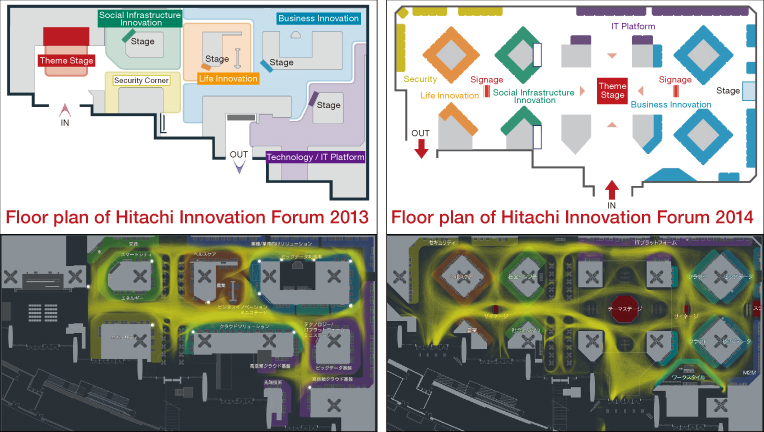
Comparison of the flow of people and the amount of time people spent in areas (indicated in yellow). Congestion in certain areas prevented the smooth flow of people in 2013, but the congestion was significantly reduced in 2014.
Furthermore, in 2014, Hitachi conducted an experiment in cooperation with NOMURA Co., Ltd., a design firm with expertise in commercial facilities and public spaces, to quantify the flow of people at the National Museum of Nature and Science in Tokyo and analyze the results as big data. The experiment was designed to determine which exhibits were more popular among children and how much each exhibit stimulated communication between parents and children. The analysis from the experiment is being used to better understand the communication patterns and relationships between people, and the results will be used as a reference for designing future exhibits.
people flow analysis can be applied to small spaces such as retail shops as well as large-scale commercial facilities and potentially even entire cities. Hitachi has been working on the optimization of entire cities to help make them more comfortable and convenient places for people to live.
For instance, if the flow and behavior of people in a city can be analyzed, energy utilization and urban transportation systems can be optimized. Other functions, such as disaster prevention and support for tourism can also be improved. Beyond easing congestion, this technology can be used as an innovative force to create cities that are more convenient for people and gentler on the environment. Hitachi will keep working to expand the possibilities using the unique insight and perspective the people flow analysis provides.
Release Date: June 2017
Solutions By: Hitachi, Ltd. Business Unit Sistemi Ferroviari
